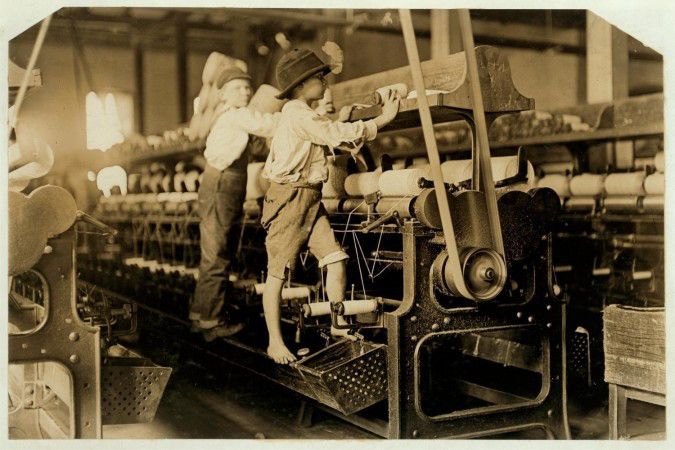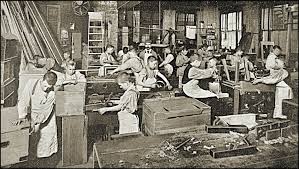
Con l’avvento della rivoluzione industriale iniziò a dilagare la piaga dello sfruttamento della manodopera infantile.
E’ importante ricordare che c’erano poche regole per i lavoratori durante la Rivoluzione Industriale e i ricchi proprietari potevano agire come volevano. Infatti, la prima legge importante creata per porre limiti al lavoro minorile fu una serie di Atti di fabbrica approvati dal parlamento britannico nel corso del 1800, questi limitavano il numero di ore di lavoro dei bambini e stabilivano norme sui luoghi di lavoro. Nel 1833 divenne illegale il lavoro dei bambini di età inferiore ai 9 anni e a quelli di età inferiore ai 13 anni non era permesso lavorare più di 9 ore al giorno.
I lavoratori venivano pagati con salari bassi che a malapena permettevano loro di permettersi il costo della vita, di conseguenza molte di queste famiglie avevano bisogno di un reddito extra tramite i loro figli che venivano impiegati in lavori molto pesanti e duri per la loro giovane età. I figli di contadini facevano lavori rurali spesso differenziati per i due sessi: pastore, contadino e piccolo artigiano per i maschi, sarta, filatrice e lavandaia per le femmine. In epoca ottocentesca, con l’avvento dell’industrializzazione ed il conseguente inurbamento, i bambini venivano impiegati nei lavori di fabbrica o nelle varie botteghe in città soprattutto perché erano più piccoli e potevano adattarsi a spazi ristretti.
Gli orari di lavoro andavano dalle 9 alle 12 ore di fila, pressoché senza pause, a volte fino alle 18 ore. I bambini subivano abusi fisici con punizioni corporali da parte dei loro capi essendo ritenuti merce di proprietà esclusiva del datore di lavoro e considerati generalmente più obbedienti degli adulti in termini di completamento del lavoro e accettazione della punizione. Le condizioni di vita nelle città erano misere e caratterizzate da sovraffollamento, scarsa igiene, diffusione di malattie e inquinamento cosicché infortuni e malanni, incrementati inoltre da una scarsa e inadatta alimentazione, portavano a un bivio nella vita di piccoli lavoratori: crescere con un fisico debilitato a vita o morire in età precoce. Influiva in maniera drastica la non affluenza a scuola, in quanto i piccoli erano occupati nel lavoro ed educati con una disciplina rigida e cruenta da parte dei loro padroni o dei familiari stessi.
A causa dei frequenti abusi subiti, durante il XIX secolo in Europa sorgevano molti orfanotrofi dove vivevano i piccoli vittime di condizioni di grave disagio psichico e fisico.
Si sceglievano soprattutto i figli dei ceti più poveri, che vivevano grazie all’assistenza dello Stato e delle istituzioni caritatevoli: i proprietari delle fabbriche prendevano infatti degli accordi con amministratori di parrocchie e orfanotrofi, i quali in reciproco accordo reclutavano i giovani lavoranti tra le famiglie più misere o tra gli orfani che ospitavano.
In Italia, i bambini venivano pagati 50 cent al giorno per una media di lavoro di 12 ore. Nel Settentrione i bambini cominciavano a essere impiegati nelle primissime fabbriche sviluppatasi durante la seconda Rivoluzione industriale, mentre al Meridione si svolgevano ancora prevalentemente attività agricole.
Di Aurora Galli
Traduzione di Aurora Galli
Child Exploitation during the Industrial Revolution

With the advent of the Industrial Revolution, the scourge of exploitation of child labour began to spread.
It is important to remember that there were few rules for workers during the Industrial Revolution and the wealthy landlords could do whatever they wanted. In fact, the first major piece of legislation created to limit child labour was a series of Works Acts passed by the British Parliament in the 1800s, which limited the number of hours children could work and established workplace regulations. In 1833 it became illegal for children under the age of 9 to work, and children under the age of 13 were not allowed to work more than 9 hours a day.
Workers were paid with low wages that barely allowed them to afford the cost of living, so many of these families needed extra income from their children who were employed in very heavy and hard jobs for their young age. Peasants’ children did rural jobs that were often differentiated according to the two sexes: Shepherd, farmer and small craftsman for the males, seamstress, spinner and washerwoman for the females. In the 19th century, with the advent of industrialization and the consequent urbanization, children were employed in factory jobs or in the various workshops in the city mainly because they were smaller and could adapt to confined spaces.
Working hours ranged from 9 to 12 hours in a row, almost without breaks, sometimes up to 18 hours. Children were physically abused with corporal punishment by their bosses as they were considered to be the exclusive property of their employer and generally considered more obedient than adults in terms of completing work and accepting punishment. Living conditions in the cities were miserable and characterized by overcrowding, poor hygiene, spread of disease and pollution, so that accidents and illness, compounded by poor and inadequate nutrition, led to a crossroads in the lives of children: grow up with a body weakened for life or die at an early age. It had a drastic effect on the lack of attendance at school, as the children were busy at work and brought up with a strict and bloody discipline by their masters or family members themselves.
Due to the frequent abuse suffered, many orphanages were built in Europe during the 19th century, where young victims of severe mental and physical distress lived.
The children of the poorest social groups, who lived thanks to the assistance of the State and charitable institutions, were chosen: The owners of the factories made agreements with parish administrators and orphanages, who recruited the young workers from the poorest families or from the orphans they housed.
In Italy, children were paid 50 cents a day for an average of 12 hours. In the North, children began to be employed in the very first factories developed during the Second Industrial Revolution, while in the South, agricultural activities were still predominantly carried out.